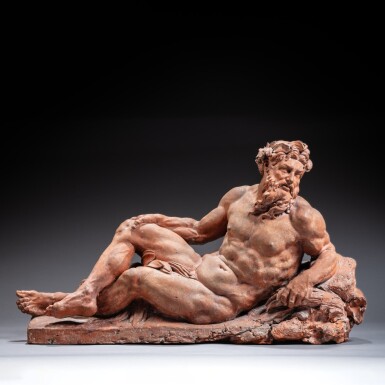
Attributed to Pierre-Denis Plumier (1688-1721)
The Scheldt River
Estimate
25,000 - 35,000 EUR
Lot Details
Description
Brussels, circa 1714-20
terracotta
38 by 60 by 16cm.; 15 by 23⅝ by 6¼in.
Probably Laurent Delvaux and Peter Scheemakers' sale, Covent Garden, London, 16 April 1728, lot 59;
Sotheby's London, 29 April 1999, lot 75 (as attributed to the workshop of Artus Quellinus);
Where acquired.
A. Jacobs, “Pierre-Denis Plumier (Anvers 1688-Londres 1721)”, in Revue belge d'Archéologie et d'Histoire de l'Art, no. LXVIII, catalogue D2, 1999, pp. 160-61, no. 39.
The attitude of this figure of a river god draws its inspiration from Ancient marbles, as well as from the monumental bronzes cast by Balthasar Keller in the second half of the 1680s, as part of the Grande Commande to decorate the gardens of Versailles. Its composition is particularly reminiscent of Antoine Coysevox's Garonne.
This terracotta river god is probably a preparatory work for the marble version of the Scheldt on one of the two wall fountains in the courtyard of Brussels Town Hall. These fountains, with allegorical figures of the Scheldt by Plumier and the Meuse by Jean De Kinder, were based on drawings by Johannes Andreas Anneessens (circa 1714) for the new wings of the Town Hall, dedicated to the States of Brabant, by the architect Corneille Van Nerven. A drawing and a terracotta model of the reclining river god, also preparatory for the marble, are in the Museum of the City of Brussels (the drawing in black chalk and white chalk highlights on beige paper, inv. L.2015.1; the terracotta, inv. B.1881.1).
Born in Antwerp, Plumier began his training with Ludovic Willemssens. We know little about his career between the death of Willemssens, in 1702, and his arrival in France, in 1707, where he won first prize for drawing, in July, at the Académie royale de peinture et de sculpture. Returning to the Netherlands in May 1710, he was appointed main sculptor to Count Jean-Philippe Eugène de Mérode, Marquis of Westerloo, for whom he created the two marble groups of the Rape of Proserpina and Abundance supported by Science and Military Strength (circa 1712; Brussels, Egmont-Arenberg Palace).
Circa 1713-14, after a possible stay in Rome, Plumier settled in Brussels and remained in the service of Leopold Philip of Arenberg, until the early 1720s. In addition to his work for the Duke of Arenberg and the fountain for the Town Hall, his Brussels period was also occupied with several religious works, including the Mausoleum of the Spinola Family (Church of Notre-Dame de la Chapelle), the allegories of Faith and Hope in Grimbergen Abbey (whereabout unknown), and the busts of the Fathers of the Church formerly in church of Dieleghem (whereabout unknown). Among the few religious works by Plumier that have survived are the pulpit of the Grands Carmes, in Brussels (circa 1720; now in the Church of Notre-Dame de la Chapelle), and a preparatory terracotta for a Virgin of Sorrows (private collection).
In 1721, Plumier moved to London with Laurent Delvaux, his most talented pupil; he was later joined by another compatriot, Peter Scheermakers the Younger (1691 - 1781). Plumier's London commissions, including the Funeral Monument of the Duke of Buckingham, circa 1721-22 (Westminster Abbey), were completed by his pupils after his death, six months only after his arrival. On returning to the Netherlands, Plumier's widow married Laurent Delvaux, and the content of his workshop, including drawings, terracottas and unfinished works, went to Delvaux and Scheemakers, who organised a sale in Covent Garden, on 16 and 17 April 1728 (see A. Jacobs, op. cit., p. 125). It is highly likely that our terracotta came from this sale, lot 59, described as ‘Two, a Satyr, and a River God by Plimier (sic.)’.
RELATED LITERATURE
M. Devigne, Laurent Delvaux et ses élèves, thesis, Royal Academy of Belgium, Brussels, 1928, p. 7; M. Devigne, Quelques sculptures conservées au Musée Communal de Belgique, SAMCB, Brussels, 1937; A. Louis, Les sculptures du XVIIIème siècle au Musée Communal de Belgique, Lecture at the SAMCB, Brussels, 1940; A. Jacobs, “Pierre-Denis Plumier (Anvers 1688-Londres 1721)”, in Revue belge d'Archéologie et d'Histoire de l'Art, no. LXVIII, catalogue D2, 1999 (https://www.acad.be/sites/default/files/downloads/revue_tijdschrift_1999_vol_68.pdf).
You May Also Like










